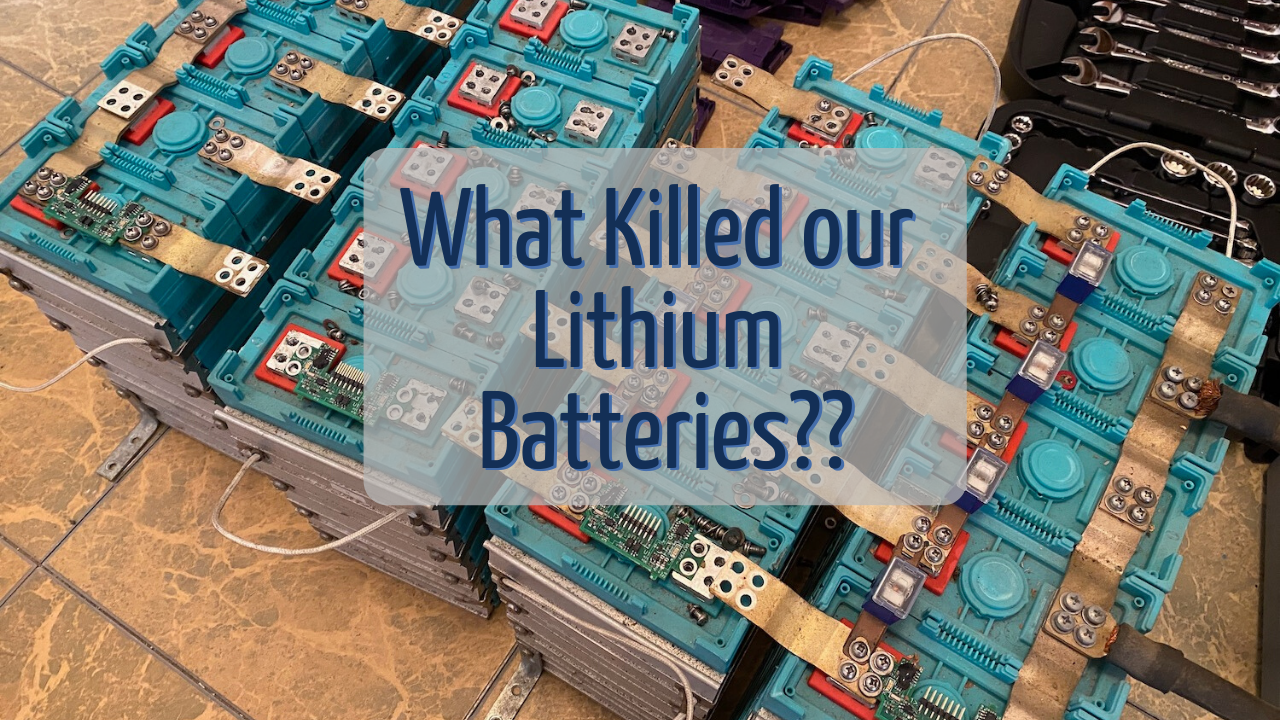
In what seems like another world now, last December we replaced our dead lithium batteries in our vintage bus, Zephyr.
We originally installed our GBS lithium cells back in August 2011 – and as far as we can tell, we were amongst the first motorhomes to have a lithium house battery system, and we were certainly one of the first to share publicly about our project.
Those batteries have served us well for years, but unfortunately – they died while Zephyr was in storage for nearly a year and a half in 2018-2019.
In this post we’ll recap our history with our bank, share what we think happened and what we replaced the dead batteries with.
First, the video version:
Brief Recap of Building our Lithium System

In June 2011, we bought our vintage bus conversion without a working house battery system installed in it.
The just emerging lithium ion battery options had already been on our radar, and since we had the opportunity to build our bus’s electrical system from scratch — we decided to delve into the world of lithium.
Specifically — we went with Lithium Iron Phosphate aka LFP aka LiFePO4.
At the time, while a few people had done installs on boats in the cruising community, there were very few RVs with lithium based house system.
Since there were limited commercial options and resources available to tap into, we decided to build our own battery bank out of cells meant for electric vehicle conversions.
We worked with Elite Power Solutions (they no longer sell directly to consumers) to reconfigure their GBS cells into a 500Ah 12v system that fit our needs.
Quick specifications of our original RV system :
- LFP — 500 AH at 12v (400AH usable’ at 80% DoD)
- Cells & EMS purchased from Elite Power Solutions in Phoenix, AZ — assembled by us.
- Chemistry — Lithium Iron Phosphate aka LFP aka LiFePO4
- Dimensions — 141 lbs, 20″³ D x 13.5″³ W x 10″³ H
- Inverter/Charger: Victron MultiPlus 12/3000VA
- System Controller: Victron Color Control GX
- Battery Controller: Victron BMV700
- Charged via shore power, generator, alternator and 800w of solar on our roof
- Installed: August 2011
- Decommissions: December 2019
Research & Analysis Articles:
Promise of Lithium #1: Lead Acid Battery Downsides
Promise of Lithium #2: Lithium Ion Battery Advantages
Promise of Lithium #3: Cost Analysis (including our part list)
Our entire Lithium Series with updates over the years:
What Killed our Lithium?

In March 2018 we left Zephyr in storage in Texas while we pursued our boating season, intending to return back that fall.
One thing lead to another (Sanford), and we didn’t end up returning to Zephyr until October 2019.
We shared some of our long term storage mistakes in this post:
Lessons Learned After Long Term RV Storage — Getting Zephyr Back on the Road
The storage unit was enclosed, with a basic 120V wall outlet power hook-up.
We were both pretty darn sick when we pulled into that storage unit, with a long drive back to Florida ahead of us. So we opted to not fully shut down and clean out the fridge, figuring we’d have power to keep it going, and we’d back in a few months.
Well, nearly a year later the storage unit suffered an extended power outage, likely caused by a storm.
And because Zephyr was indoors her solar panels weren’t overly useful in helping out with the situation (ok, not useful at all).
While the power was out, the fridge drained the batteries to the cut-off point of 11.2 volts, triggering the battery management system to automatically pull the plug to save the pack.
That would have been all fine and well – exactly as the system was designed to do.
But the way our system is designed – the EMS does not automatically reset once power comes back on. Once the low-voltage shut off is triggered, it needs to be manually reset.
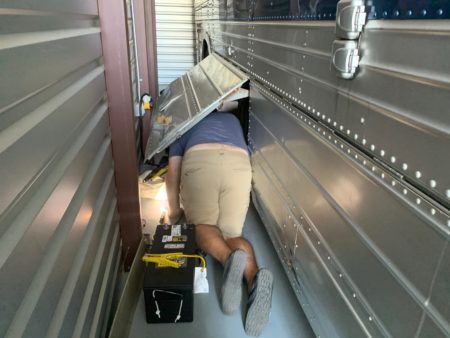
So… we didn’t have a way to remotely reconnect the battery pack when the power came back on.
And my brother – our local contact in Texas near the storage unit – wasn’t able to get to the storage unit for several weeks to be our on-site hands.
And when he finally did get there, he was unable to restart the system with Chris directing him through the steps on the phone.
It’s rather tight in the storage unit requiring some gymnastics to get into the bay where the batteries and inverter are – and it is actually pretty tricky to manually reset things.

We decided to just leave things be and hope the pack was recoverable when we returned.
Well, it turns out that while the pack was off – the balance boards on each cell have a little stupid LED light on them that remained glowing and slowly draining the battery.
That wouldn’t have been a problem for a few weeks – but after nearly six months that constant low draw dropped the voltage into the 1.8V – 2V range.
Yup.. little blicken LED lights likely killed our batteries.
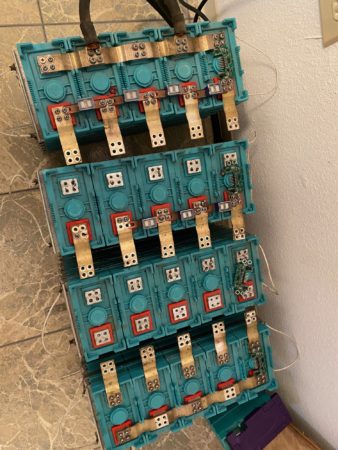
While the pack might be recoverable from this (and we were able to trickle charge them) – Elite Power advised us that the batteries are very likely internally damaged via crystallization from being taken down so low.
And thus, our 8.5 year old lithium pack was declared dead.
Up until the failure – our batteries had been performing well.
We did have some initial issues with the batteries prematurely aging and losing some capacity in their first two years installed – due to heat and a few other issues discussed in the post above.
But after having resolved those root issues, our original 500 Ah battery bank had been providing a reliable 380 Ah over years of heavy usage.
We fully anticipate that had we not run into the storage power outage situation, we would have gotten the anticipated 10+ years out of pack that we had anticipated in our original cost analysis.
So thus overall, we consider our experiment with lithium batteries a success – with many lessons learned along the way that hopefully have helped others.
Our Replacement: Battle Born

A lot has changed in the world of RV lithium since we started playing around with them. There are now many distributors, installers, and consumer friendly drop-in solutions.
You no longer have to build your own pack from scratch… unless you want to.
In September 2018 we accepted Battle Born Batteries (affiliate link) offer to trial their drop-in batteries on our boat, and installed a 300 Ah 24v system.
For a full tour of our Boat’s solar/battery system:
Tour of our Boat’s Electrical System, Solar, Lithium & Inverters!
We’ve had no issues with that system, and give Battle Born overall a thumbs up.
It’s awesome to have a company that is knowledgable, stands behind their product, and offers a 10-year warranty – and is still reasonably priced. They have been making lithium for RVs more mainstream.
Battle Born’s 100Ah cells are priced at about $1000.
For comparison, we paid about $4000 (cells, fuses, EMS, etc.) for our original 500Ah pack – and had to build the thing ourselves.
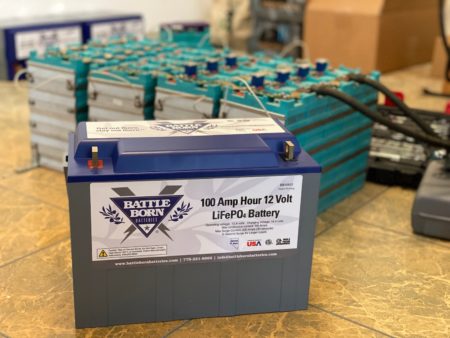
Apparently our sharing about our original system is in part what inspired Battle Born to go into business, so when they heard that our original bus system had died – they stepped right in to offer batteries for Zephyr too.
We’re extremely grateful.
While it was our goal to eventually put 800-1200Ah of capacity into Zephyr – our lives have changed since then.
We’re now part-timing on the bus, and our boondocking time will only be a part of that.
And we will be in the bus in winter, not hot summers that we were designing our system around running overnight AC off of battery.
So we opted to stay small so we wouldn’t have to re-engineer too much.
We put in 400Ah at 12V, which should be 100% usable. Our original system was already at only 380AH of capacity – but we considered only about 80% usable.
So the new system is a capacity upgrade.
We were also very fortunate to have friends Larry and Maribeth join us at our Co-Op park in Benson, AZ for the holidays. They had just happened to have completed their own lithium install a few weeks prior, and they had excess cabling and parts they were ready to offload – saving us from needing to order in new battery cables.
Chris and Larry were able to knock out the removal of the old batteries and install the new ones in pretty quick order.
And projects are always more fun with friends!
The old batteries were actually much harder to remove than putting the new ones in, because the giant 500Ah slab was too big to slide out past the inverter and they needed to be separated in place.
What happened to the old batteries? We were starting to research proper disposal in Arizona when a Facebook follower in the area asked if he could have them to experiment with. With a full disclaimer of their history & risks, we were happy to send them on.
We’ve not heard back if the pack was ever recoverable.
After installation, it was off back into the desert for a month of boondocking while we attended Xscapers events in January.
I think we took some footage sharing how our off-grid systems performed – next time I have some open time, I’ll try to dig that up and put something together.
Disclaimer: While Battle Born provided our batteries for both the bus and boat, we have received no compensation for writing this post. In fact, there was no expectations of ever sharing anything in accepting their generous gift. The did however set us up as affiliates, so if you decide to purchase Battle Born Batteries yourself with our link, we do get a little kick back. Thank you!







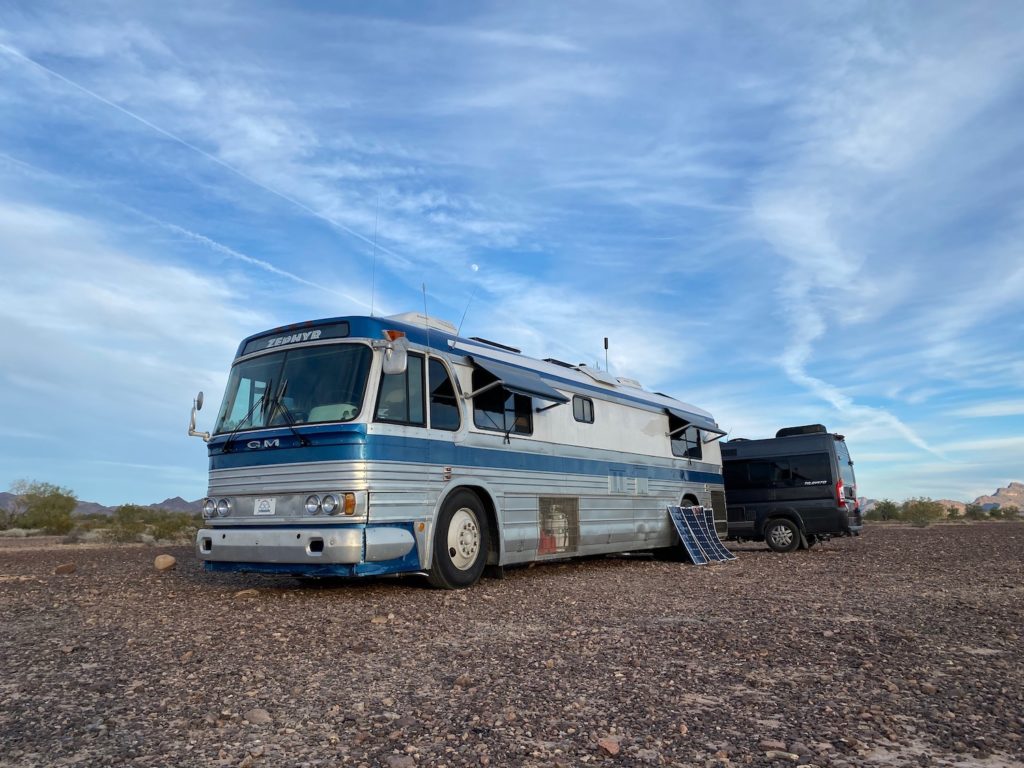
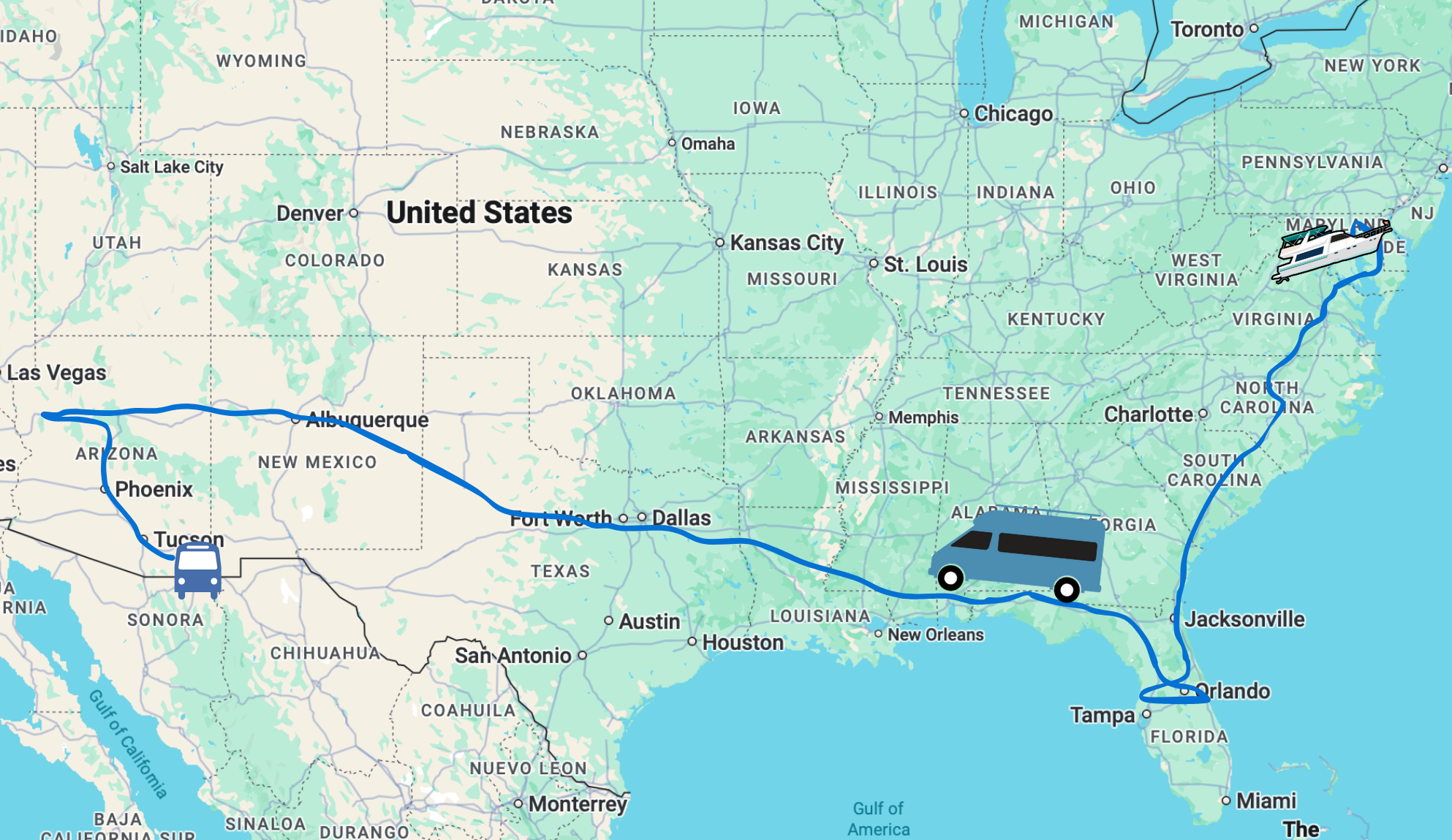
Good to know.
Li isnt quite as “perfect” as made out to be by sellers.
All electronics have parasitic power draw. The BMS will eventually drain a battery faster than the cell would degeade alone.
Life is not forever. Most people will never approach cycle life….but calendar life is real….20% capacity loss at 10 yrs treated perfectly.
Throw in cycle life, charging abuse, temperatures, etc …..5-7 yrs is realistic life 9f lifepo4 .
Cars used daily will be 60% of capacity at 10 yrs…..half calendar aging, half cycle.
Chris, Cherie, I’m sorry to hear of your bad luck. I found your blog after I had already invested in an 800ah system for our coach, Late but not too late, and I learned a lot from you. We have ours for 5 years now and, maybe from my neglect, have lost about 100ah of capacity. Most of our loss was due to charging parameters I’m sure. However they were used and I didn’t check the capacity in the beginning. I bought these cells on ebay, from a shop that wasn’t happy with their electric car conversion. I was lucky to get them for about the cost of AGM’s.
For the house, I have 32 each – 100 Ah CALB cells configured 8p x 4s for 800 ah 12v on paper. And for a starting battery I have 16 more cells configured 4p by 4s for 400 amp hrs. There seems to be no CCA equivalent for LiFePo batteries but I’m guessing it would be over 2500; it easily starts our 10 liter Cat engine.
I have no BMS at all, no balancing, no low volt cut out, no lights, nothing. I do the battery management by hand. It’s easy to check the voltage on each parallel cell bank, if I find a difference in voltage I can parallel balance them, I’m just about to do that for only the second time.
I do have lots of vampire loads in this old coach so I must keep it plugged in all the time in storage. The charger is a state of the art 1999 heart inverter charger with only 4 charge parameters to choose from. When I started out I looked at the spec sheet and saw that 14.4v was max charging voltage so I used a too high of a charge for the 1st year or two, and of course the float was too high. Now I’m using a bulk charge up to 14v and no absorb and a float of 13.1v, about 80% capacity. I do have available a charge program that charges to 13.8v but the float is too high.
I added a Balmar programmable alternator regulator to keep the charge down while driving and it has a temp control to reduce charging in high temps. I also added heating elements under the cells to hold the temps at 38 f, but I have no remedy for high temps. Spec sheet says I can charge up to 45c, I have always gotten uncomfortable above 95f, I then move north and uphill.
I had heard early on, that a BMS could cause problems and that the easiest way for a cell to get out of balance was if there was a separate way to put a draw on that cell, such as with a BMS. I didn’t know they had leds and I didn’t know about the reset either. Also, did I mention that I’m cheap?
Anyway, I love my Batteries and I’m happy to hear you are making a rebound with Battle Born.
Ed Recknagle, 2000 Country Coach Magna 36
Wait, the cost per kWh for the battle born batteries is higher than what you paid to diy 8.5 years ago! Whatever happened to lithium battery prices supposedly decreasing over time lol battle born seems like a quality battery just really expensive! For those wanting to DIY today you can do it for about 1/5th the cost using the same cells that battle born uses. But of course getting them free is even better 🙂 That is cool your original diy story inspired them. Cheers!
As you’ve seen – DIY costs have been decreasing, and more mainstream batteries are often discounted some too.
But I think there is so much demand for batteries from the electric vehicle market that it has kept prices for individuals up high, even though the raw costs have been plummeting (when you buy at the scale of Tesla).
thanks for sharing. cheers from SvHappyJack and Sv3hourTour see you on the water.
It was a real cutting edge project at the time. Interesting that Battle Born followed your original project, at least to some extent. It’s sad that the cells come out of China, except the few that GM makes and all the stuff Tesla makes but does not share. Of course, this is LFP and that’s a China thing.
It’s much easier now, and the comfort level is much higher. If someone wants a project buy the BMW 32 kWh module from Battery Hookup. (Or smaller ones.) Just put the pieces together like Morton did with the Tesla module. I mean, gee, the BMW module is $3k, so a hundred bucks a kWh. Battle Born does what they do, but they are a bit steep.
I wanted to build out a Promaster with enough insulation to run a split heat pump, heat and cool. Mostly off solar and lith. But, it’s been a lot of years since RV people started down this road, and none of it seems that fresh, now. On the other hand, it just works. I have my CALB and it’s a great tech.
Ten years seems a bit arbitrary. They might last 20, with some degradation, so it does pay to protect them. Maybe they turn into a pumpkin at ten years, I don’t know.
That really and truly sucks. But as soon as you mentioned “storage” I thought….”Uh-oh!”. Not sure what you could have done to try and ward off the failure apart from having some sort of human intervention on a regular basis.
I vividly recall having the sudden realisation that my lithium batteries that were languishing back home when we lived in Austria were needing to be charged from time to time. Thankfully my son-in-law was able to sort that out for me, and those batteries are still fine. Those suckers are expensive.
This is good info for all concerned. Thanks for making the effort.
Take care, and carry on!
Hey Guys,
I had a very similar experience — a pack of CALB batteries that had been going fine for 5 years, and then experienced an unintended power outage while in storage. Like yours, my batteries went down to cutoff, disconnected, and then were flattened by the parasitic currents from my BMS.
I thought about Battle-Born (and Relion and others), but opted again for CALB due to space and dollars. This time, I’ve used a zero-current BMS with no balancing, and I do the balancing manually now and then.
Fingers crossed, so far so good.
G.
I truly appreciate that you provide text as well as video. My time is short and I love being able to scan the text for information useful to our situation and not have to commit to a much longer period of time to watch and listen to a video. I do very much enjoy the videos, especially on the boat or when I need to see the detail discussed, but, time is short. Thanks for doing both.
It takes a lot of time to create both… which is why this post is about 6 months over due :). Glad the effort is appreciated. Our free time is limited too, and we provide this blog ‘just for fun’.
Really enjoyed your video on lithium batteries. That must have been a lot of work to build the first set. Glad Battle Born made the job much simpler. I am learning a great deal from the videos. Glad Zephyr will be ready for winter travel. Be safe and be well.
Thanks for the info, Cherie! I currently have 4 AGM batteries that are still functioning after 10 years (!) in our ’79 MCI but I know I need to replace them. We do *some* boondocking, but more often have hookups. We travel about 8+ weeks/year, generally in the fall to avoid extremes in temperature. What are your thoughts on AGM vs Lithium in a situation like ours?
Only you can determine what is right for your setup. We all have our own balance between budget, convenience, weight, longevity and tech. For most, the numbers don’t work out for occasional use.
I saw your battery system back when I was building a school bus conversion in 2014 and it encouraged me to keep pursuing that system. Now we live full time and our 450 ah battery @56 volts is essential to our home.
Thanks for taking those steps back then!
I have followed you for the last 4 years or so, but my interest peaked when I sold out in East Texas and lived fo 6 months in a 14′ cargo trailer (with AC and some electric!) I now live south of Colorado Springs and as an RN I am in Boston, MA helping out. You guys are infectious!. I just made a deal for a 1955 4104. I can’t wait for my last week to be done to get on the road to CO, unload and catch a flight to Portland to meet my new home away from home.
My plans are to use it as a traveling nurse to NOT have to stay in a hotel as often. Also to spend more time with the grandkids in nature. I’ll invest in upgrades and do some remodeling as I go, since I have a lot of skills and way too many tools.
Keep the great things coming and I hope to catch you down the road!
Oh yes, I heeded your advice and didn’t jump on the first bus I saw. Spent some time, and even flew my son-in-law to Houston to check one out. I found that elusive perfect seller. A great bus, Fabulous condition, and a really good price!
Wow. A lithium battery lasting 8.5 years is freaking amazing. Thanks for sharing this !!!
They should last 10+ years… we were hoping to reach that mark before replacing. Oh well.
Hi Cherie, Thanks for a fascinating post. I’ve finally found a battery that can “do the deed” at -40. It is an SiO2 chemistry. It shares many attributes of the LiF, except two. One is weight–which is a bit heavier than AGM or lead acid, the other is the ability to charge in extreme cold. They are about 1/2 the price of Battleborn (which is an excellent firm imo) for the same capacity. Cycle life to 50% is 2800, and to 80% is 1500. However, I’m no longer full time and so won’t need the sort of capacity I had before.
Thanks for the update Cherie. We just purchased Battleborn batteries for our coach and so far so good. We also saved money using our Escapees discount.